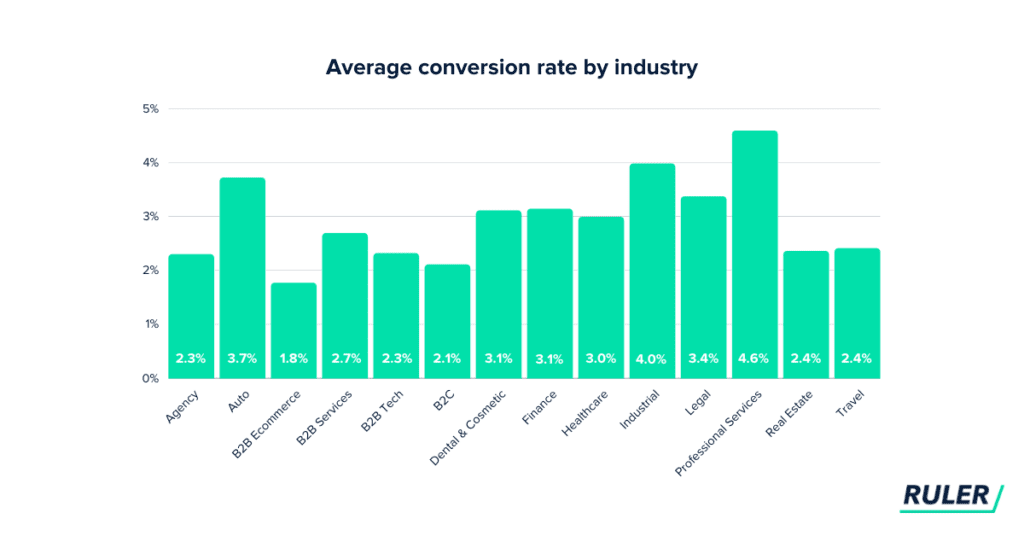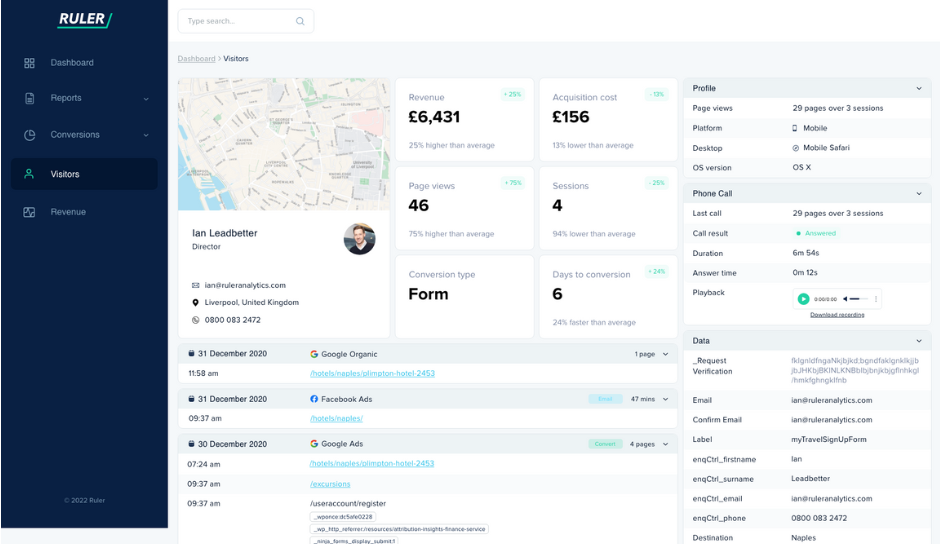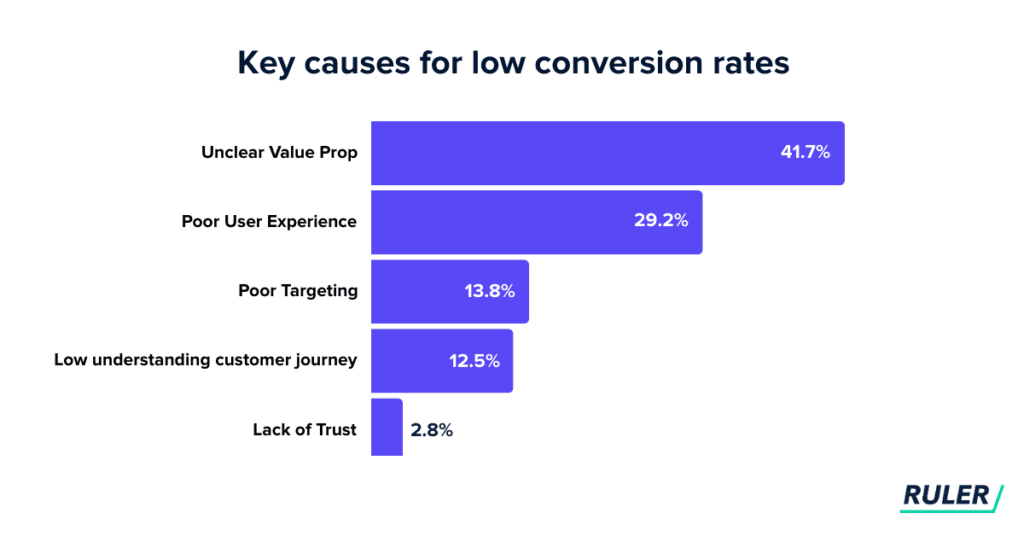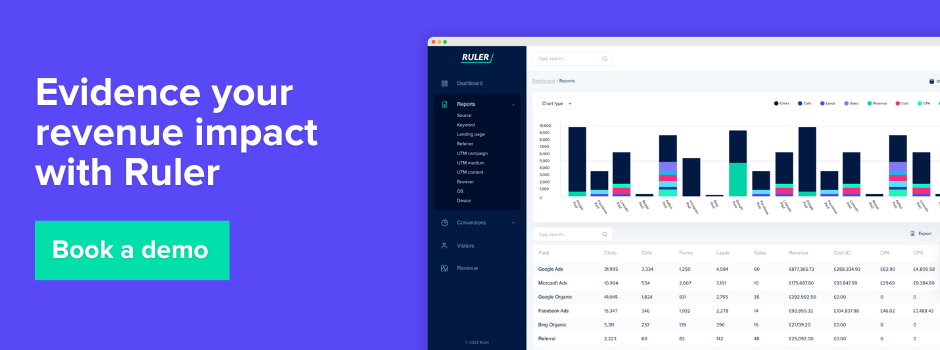Identify common roadblocks and uncover actionable fixes to boost your conversion rates.
Convincing leadership of marketing’s value is tough.
They demand a clear connection between every marketing dollar spent and measurable results.
Yet, many marketers face a frustrating reality: high traffic with a low conversion rate.
Clicks just aren’t converting into leads, sales, downloads, or sign-ups, leaving a trail of unfulfilled potential and unanswered questions about ROI.
“Managing conversion rates can be a complex task, and when they’re low, it can feel like a persistent headache,” says Laia Quintana, Head of Marketing and Sales at TeamUp.
Understanding the root causes of low conversion rates is essential for any marketer seeking to optimise campaigns and secure continued investment.
To address this challenge, we asked experts to pinpoint the major obstacles hindering conversion rates and share effective strategies to improve it.
Here’s what we’ll cover:
💡 Pro Tip
Forget last-click attribution and siloed data. Ruler tracks visitor interactions across campaigns, ads, keywords, and more. It also captures leads from live chat and phone calls. This multi-faceted approach ensures you see the complete picture. No more missed conversions, just a clear understanding of which touchpoints are driving success. The result? Conversion rates that finally reflect reality.
Book a demo to see how Ruler links conversions and revenue to marketing
There isn’t a one-size-fits-all answer to this question, as conversion rates can vary depending on several factors, including:
Before you embark on your quest to improve your conversion rates, it’s always helpful to benchmark your performance against industry averages. This way, you can set realistic expectations for your own conversion goals.
We sampled the Ruler global database, which has over 100 million data points, to distinguish the average conversion rate across fourteen industries. This is what we found:

Here we can see that industries selling expensive products or services like holidays and real estate typically have lower conversion rates compared to those with lower price points, highlighting the importance of comparing your business against industry benchmarks.
Tom Golubovich, Head of Marketing at Ninja Transfers, agrees with this approach: “Start with a competitor analysis to determine whether your conversion rates or expectations are out of whack. Once you have a solid benchmark of rates, you can dig into site performance data to find where users drop off and start A/B testing every relevant element.“
💡 Pro Tip: Discover how your industry stacks up. This blog provides a comprehensive analysis of conversion rates for phone calls, forms, and overall performance across the different industries listed above. Average conversion rate by industry and marketing source
The traditional conversion rate, calculated as the number of conversions divided by total visitors, offers a seemingly straightforward metric for measuring success.
However, it’s crucial to understand that the conventional method of calculating conversion rates can sometimes present a misleading picture. Here’s why:
To gain a more accurate picture, we track the customer journey through marketing attribution. This helps us understand which channels, ads, and keywords contribute to conversions across various touchpoints.
“It is really important to consider the visitor’s journey and ensure consistent content and wording throughout,” added James Taylor, SEO Strategist at Embryo Digital.
We leverage our own solution to track the click path data of anonymous visitors, allowing us to see their origin (marketing channels, ads, keywords) and how they navigate our website.

While attribution can’t capture every touchpoint, it offers a far more realistic picture of how your web pages and marketing channels are converting leads. If you’re interested in learning more, we have a comprehensive guide on how Ruler tracks full customer journeys.
While conversion rate as a metric has some restrictions and should be taken with caution, it’s still important to consider. Conversions are the lifeblood of any business – without them, there’s no fuel for growth.
Recognising this importance, we recently surveyed 75 professionals to identify the most common culprits behind low conversion rates:

Let’s delve into these reasons and explore actionable steps to address them.
“Through my experience in both marketing and cybersecurity, an unclear value proposition is often the root cause of low conversion rates,” says Taimar Ijlal, Tech Expert & Security Leader at Netify.
A staggering 41.7% of respondents point to unclear value proposition as the primary culprit behind low conversion rates.
An unclear proposition acts as a barrier, preventing potential customers from understanding your value and guiding them towards a conversion.
Michael Sawyer, Operations Director at Ultimate Kilimanjaro, emphasises the importance of a clear value proposition, highlighting how a confused visitor is a lost conversion:
“What is the issue with an unclear value proposition? Well, usually it means that the visitors on your site don’t fully understand what you are offering or why they should choose you over your competitors. Meaning that you leave them in limbo, without a clear choice.”

Olivar Brandrup, Director of SEO at Neurogan, dives deeper into the specifics, highlighting the crucial role of clear product information: “In my experience, one of the worst culprits for low conversion rates is unclear or inadequate product information.”
In today’s discerning market, where attention spans are short, murky details act as a major deterrent. Brandup goes on to say that a lack of transparency can even damage trust, implying the brand has “something to hide.”
Paige Arnof-Fenn, Founder & CEO at Mavens & Moguls, reinforces the importance of a clear value proposition on the homepage, the crucial first point of contact: “Your home page is the most important to hook in prospective customers. You must include enough of your value proposition to start the conversation.”
Nearly a third (29.2%) of marketers say an unclear value proposition is the biggest hurdle preventing customers from buying.
Kevin Watts, Founder at Raincross, believes: “Many businesses invest heavily in ad campaigns and SEO, only to drop the ball when it comes to the actual experience visitors have on their website.”
Imagine a physical store with cluttered aisles, confusing signage, and unhelpful staff. This is exactly the experience a poorly designed website creates.
Keith Donovan, Startup Advisor at Startup Stumbles, echoes this sentiment: “One big problem I see is when companies make things too confusing for people. They use words nobody understands or they don’t explain clearly what problem their product solves.”

In today’s digital landscape, users expect a smooth, intuitive, and engaging experience.
Pavel Naydenov, Head of Marketing at Businessmap, emphasises this point: ” If your site has complicated navigation, slow load times, or a confusing layout, it will deter users from proceeding further into the conversion funnel.”
A recent case study from Businessmap exemplifies this perfectly. Upon analysis of a 40% drop in conversion rates, they discovered the culprit was a slow loading homepage, causing visitors to bounce before even exploring their services.
Don’t take our word for it. Studies show that a well-designed user experience can significantly boost conversion rates.
Sam Jacob, Head of Marketing at Ammo.com, cites research by Forrester which shows that “a well-thought-out UX design can increase conversion rates by as much as 400%”.
“Low-quality traffic is one of the most common issues keeping conversion rates down,” says Colt Agar, Organic Marketing Lead at Red Stag Fulfillment.
Another culprit behind low conversion rates is poor targeting and segmentation.
As Anna Parvatova, Brand Manager and Creative Director at SNS Nails, points out, “One of the most common reasons for low conversion rates is poor targeting.”
Imagine investing in a campaign to promote high-end nail polish. A broad approach aimed at everyone might generate a lot of clicks, but as Parvatova highlights, “targeting a general audience rather than beauty enthusiasts with disposable income can lead to a lot of irrelevant traffic.”
These visitors, with little interest in your specific product, are unlikely to convert.
Ryan Farley, CEO at LawnStarter, agrees, “The vast majority of the time, if you’re having trouble with your conversion rate, the problem lies in the leads you’re generating in the first place.”
Simply attracting visitors isn’t enough. You need those who are genuinely interested in what you offer.
Experts like Gabriel Lukov, Head of Inbound Growth at Businessmap and Ginaluca Ferruggia, General Manager at DesignRush, both point to a common offender: low understanding of the customer journey.

We touched on the evolving customer journey earlier – it’s no longer a linear path from awareness to purchase. Today’s consumers navigate a complex web of touchpoints, both online and offline, before making a decision.
Chances are your bottom-of-the-funnel campaigns see higher conversion rates than your top-of-the-funnel campaigns. That’s because they’re targeting users already primed to buy.
However, those awareness campaigns planted the seed – they introduced your brand, sparked an interest, and ultimately contributed to the final conversion.
But without a comprehensive understanding of the entire customer journey, your early brand awareness efforts will always appear less effective than they actually are.
Pro Tip: Measuring the success of brand awareness campaigns on platforms like Meta, YouTube Ads, and TikTok can be tricky because they don’t directly drive website visits. This lack of immediate conversion data makes it difficult to assess their true impact and can lead to budget cuts. Ruler’s impression attribution links upper-funnel channels to revenue, giving us a clearer view of campaign effectiveness.
“A lack of trust plays a significant role. When potential customers don’t have confidence, they are unlikely to convert,” says Pavel Khaykin, Founder at Pavel Buys Houses.
Last but certainly not least on our list of conversion rate roadblocks is lack of trust. According to our survey, 12.5% of respondents believe it’s the main culprit behind disappointing conversion numbers.
“In the digital age, consumers are rightfully cautious about where they spend their money,” says Marc Bishop, CEO at Wytlabs.
He hits the nail on the head – with so many scams lurking online, websites need to actively build trust with visitors. This means showcasing clear trust signals like SSL certificates, user reviews, and easily accessible contact information.
As David Ciccarelli, CEO at Lake.com, puts it, “Without trust, you can build the most beautiful website, but no one will want to buy what’s inside.”

Martin Gasparian, Owner Attorney at Maison Law, reinforces this point. “Simply creating a website and expecting customers to convert is unrealistic. They need to be convinced they’re dealing with a legitimate business.”
Now that you understand the common reasons behind low conversion rates, it’s time to turn things around. Our conversion experts share powerful techniques to transform your website visitors into paying customers.
“To enhance the conversion rate, my number one recommendation is improving the user experience. A well-designed and intuitive website not only reduces the bounce rate but also makes it easier for potential customers to complete conversions,” says Eva Miller, VP of Marketing at Digital SIlk.

Before you delve into complex conversion rate optimisation strategies, take a step back and assess your UX. It might just be the first (and most important) step to getting those conversion rates singing.
Here’s a few ways to get started:
Optimise load speeds: Research shows that even a one-second delay in page load time can lead to a 7% reduction in conversions. “Tools like Google PageSpeed Insights can help identify and fix speed issues,” added Mark McShane, Founder at Cupid PR.
Simplify the navigation: Emily Smith, SEO & Content Manager at Jewson, believes that “your website’s navigation needs to be intuitive and straightforward. Users should be able to find what they are looking for within three clicks.”
Enhance mobile experience: An easy navigation goes beyond the desktop. “With an increasing number of users accessing websites via mobile devices, a responsive design is crucial. Make sure your site looks and functions well on all screen sizes,” says Simranjeet Singh, Co-founder at Search My Expert.
Utilise bullet points: “Make bullet point lists of benefits and features that should be placed on your product pages and headlines that appeal to the target audience,” recommends Chris Townsend, CEO at Three Movers.
Introduce more visuals: Short attention spans online are no secret, but visuals can break through the noise. Images, animations, and videos can grab attention and keep viewers engaged. Jeremy Bogdanowicz, Founder & CEO at JTB Studios, suggests “posting 3D visuals of products to highlight its features or showing an animated video to depict the journey of its formation.”
Simplify your CTAs: A CTA can make or break your conversion rates. “Ensure that your CTAs are straightforward and compelling. Instead of a generic ‘Contact Us,’ use something more specific like ‘Schedule a Free Consultation Today’ or ‘Get Your Personalised Property List,’ says Adam Chahl, Realtor & Marketing Expert at Vancouver Home Search.
A/B testing frequently: Regularly perform A/B testing on key pages to identify what works best for your audience. Joe Smith, SEO and Conversion optimisation expert at OakStreet Technologies, shares an example: “Changing and testing the colour of your CTA button or modifying the headline can significantly impact conversions.” Remember to start small, make changes one by one and use real results to inform your optimisation process. “It’s slow and steady that wins the race here. You’ll avoid wasted ad spend and uncover important insights faster by taking a scientific, data-driven approach,” says Kelly Indah, Tech Expert & Security Analyst at Increditools.
Invest in the right tools: Heatmap and session recording tools like Hotjar and Crazy Egg can reveal areas for improvement. “These tools pinpoint where users click, scroll, and linger, helping identify frustrating elements, according to Matt Shak, CEO of nerDigital. Duncan Cole, owner of Phresh SEO, echoes this, highlighting the value of “session replays in exposing user experience issues and drop-off points.”
When it comes to online purchases, a smooth checkout process is the golden ticket to boosting conversions.
Matt Aird, CTO at Custom Neon, suggests, “reducing the number of steps required to complete a purchase.” Their one-step checkout resulted in a clear uptick in sales, proving that less can definitely be more.

This focus on simplicity extends beyond the number of steps.
Stephen Greet, CEO & Co-Founder at BeamJobs, highlights the importance of clear progress indicators. “We incorporated a step-by-step progress bar,” he explains, “to provide visitors with a clear understanding of where they were in the checkout process.”
This transparency keeps customers informed and engaged, preventing them from getting lost or frustrated.
But what about businesses that don’t sell physical products?
The same principles apply. Lead generation forms are essentially your checkout process for capturing valuable customer information.
Valerie lavskaya, CMO at Promodo, advises to “review your forms, buttons, and calls to action, with a focus on removing unnecessary elements.” Every extra field you add is a potential hurdle for someone to complete your form.

Leo Smigel, Founder & Personal Finance Expert at Analyzing Alpha claims, “shortening forms from 11 fields to 4 increased conversions by 120%.”
Adam Degraide, CEO of BamTastic Games, believes, “a clear, compelling value proposition is front and centre” when it comes to boosting conversions.
Simply put, you need to offer something unique that sets you apart from the competition.
But it’s not enough to just have a great product or service – you have to communicate its value effectively.
“Make the visitor’s choice easier by distinctly presenting how your offering stands above the rest,” adds Nick Drewe, Founder & CEO at Wethrift.
It is tempting to get caught up in features and technical jargon, but as Kurt Uhlir, CMO at EZ Home Search, reminds us, “While marketers tend to think about value propositions from the company or product standpoint, it’s more important to understand all of the things your potential customers are attempting to accomplish.”

Carl Brodbent, Founder & Digital Marketing Expert, echoes this, “Stop visitors from having to deduce your message and just straight up tell them how your product or service will make their life better.”
But how do you know what truly resonates with your audience? Conor Hughes, Human Resources Professional at SMB Guide recommends, “Putting yourself in your target audience’s shoes.”
He offers a real-world example: “One client I worked with realised their strongest value prop was saving time and headache around cumbersome review processes. We refocused their messaging around this core benefit, and conversion rates increased 34% month-over-month.”
By prioritising customer needs, they were able to significantly improve their conversion rates.
We’ve discussed how a strong user value proposition and a seamless user experience are fundamental to boosting conversion rates—but how do you ensure you’re delivering on both fronts?
This is where analytics and data become your greatest allies.
Brooke Webber, Head of Marketing at Ninjapatches, highlights, a data-driven approach is key: “Look at site analytics to see how users interact, survey your audience, and analyse competitors to see what’s working well for them.”
“You can map out their psychographics, challenges and typical objections” adds Kevin Dam, CEO & Founder at Aemorph.
By understanding how users navigate your site, their pain points, and what resonates with similar businesses, you can tailor your offering and experience accordingly.
Rex Huxford, Director of Demand Generation at MDClarity, underlines the importance of analysing user behaviour throughout the entire conversion funnel: “Look at user behaviour on your site. If they’re not even making it to your site in the first place, check marketing strategies, ad campaigns, and more.”

Data empowers you to pinpoint areas for improvement, whether it’s refining marketing strategies, optimising landing pages, or streamlining the checkout process.
The example of Pro Supps, a fitness supplement brand that Dan Ben-Nun, CEO & Founder at Adspace mentions, perfectly illustrates this point.
“Through in-depth analysis, Adspace identified areas for improvement in Pro Supps’ marketing strategy. By implementing a data-driven approach that included targeted advertising and personalised email marketing, Pro Supps saw a dramatic increase in website traffic and conversions.”
A flawless website and compelling value proposition is only half the battle.
“New visitors want reassurance, especially when it comes to online purchases,” says Josh Neuman, Founder at Chummy Tees.
They need to trust you before they take the leap and convert, whether that means making a purchase, subscribing to a service, or downloading an ebook.
Mark Pierce, CEO & Founding Partner at Wyoming Trust, agrees, “Trust is everything.” He continued, “Audiences need to understand implicitly, just by perusing your website, that you’re reputable and authoritative and are the clear choice to give their money to.”

Here are different ways to build trust:
Reviews: Demonstrating positive experiences with other customers is an easy way to build trust. As Magee Clegg, Founder & CEO at Cleartail Marketing, highlights: “we helped a client generate 170 5-star reviews within a two-week period on their Google listing, which significantly boosted their credibility and ultimately their conversion rate.”
Customer testimonials: “Showcasing real-life examples through case studies or video tours can provide tangible proof of effectiveness, greatly improving trust and thereby boosting conversion rates,” says Eugene Klimaszewski, Founder at Mammoth Security. This aligns with Michael Nemeroff’s point, CEO at Rush Order Trees, that you need to “show users how you’ve helped others and communicate transparently.”
Easy returns and money-back guarantees: Taking the worry out of trying new products is key to building trust with customers. James Wilkinson, CEO of Balance One Supplements, agrees, “Make it easy for the reluctant customer to overcome their doubts. Our easy return policy and money-back guarantees show confidence in our products and will reassure the reluctant buyer.”
Feedback form: “You can also keep a feedback form on your website, where the visitors can leave a comment,” says Harrison Tang, CEO at Spokeo. By offering a feedback form, you’re essentially saying to your visitors, “We value your opinion, and we want to know how we can improve.”
Louis Levine, Marketing Manager & Mortgage Broker at Expat Mortgage confirms that “these are things that reinforce your authority in an industry and build trust with potential buyers.”
The world of online sales can feel like a delicate dance. You’ve got potential buyers browsing your products, but sometimes they need a little nudge to take the final leap and convert.
Joshua Wood, CEO & Founder at CJ Digital, points out, “businesses can create urgency by putting a timer on a special discount. They can also use scarcity. This psychology hack makes people act and stops them from shopping around.”

But what about potential customers who aren’t quite ready to commit? Jonathan Feniak, General Counsel at LLC Attorney reminds us, “It’s all about layering little nudges.”
Even if a purchase isn’t happening right now, you can still stay relevant.
Nick Valentino, VP of Market Operations at Bellhop Movers, emphasises the importance of keeping yourself “on their radar.” Regular check-ins through social media, emails with “useful information,” or even a birthday message can go a long way.
In fact, Dillon Hill, Owner at Cosmoforge, experienced a notable improvement in conversion rates with this strategy.
“One of our e-commerce clients observed a 30% increase in conversion rates after we launched targeted email campaigns. These campaigns focused on educating the audience about the product benefits and featured customer testimonials to build trust.”
Hopefully we’ve shed some light on the reasons behind low conversion rates and, more importantly, equipped you with actionable strategies to turn things around.
Remember, a healthy conversion rate is all about understanding your customer journey and optimising every touchpoint.
Our marketing attribution software tracks the full customer journey, giving you a clear picture of how leads turn into opportunities and deals.
With Ruler, you can pinpoint exactly where optimisations are needed, leading to a more accurate conversion rate you can trust.
Ready to see Ruler in action? Book a demo today and see how our attribution can help you skyrocket your conversions and revenue.
